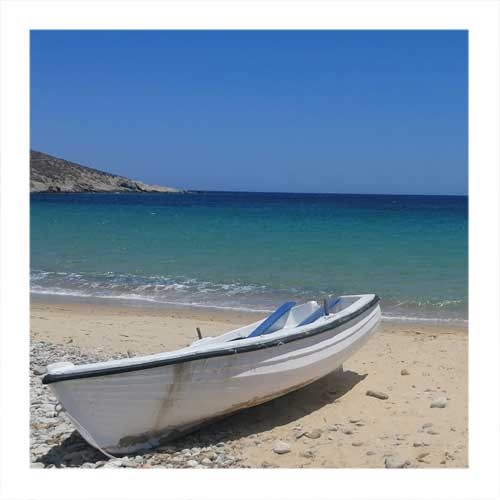Starting with Ancient Times, the island was settled during the
prehistoric period and there is evidence that the island was inhabited from Bronze Age (around 2000 BC).
Serifos was known from ancient times for its (iron) mining, this was mentioned in ancient texts of that time.
Serifos is close to the mainland and this made it an attractive spot for settlement.
Mythology plays a big role on Serifos, the Medusa, Perseus, the king Polydectes,
his brother, the fisherman Dictys and the Cyclops are the islands' most famous 'inhibitants' or VIPs.
Follow this link for more history about Serifos...
https://www.100percentgreek.gr/serifos-mythology.html
During the classical period, Serifos became interesting for Athens and other places in Greece
because of its known iron-mining activities. It brought work, trade and wealth to the island.
Under the Roman Empire (around the 2nd century BCE) many islands in Greece were controled. Serifos
though remained a quiet and minor part during the Roman Empire period. Only the island's mining operations
continued playing an important role for its economy.
During the Byzantine Era (around 330–1453 AD) Serifos became a part of the larger Byzantine Empire.
Due to the islands geographical location, it was a good spot for controlling Aegean sea routes. Serifos' importance was mainly military and economic reasons during this period.
The Venetians (Venetian Rule 1204–1571) took over many parts of the Aegean.
They constructed fortifications on the islands to protect against pirate.
Serifos geographical position once again made the island an important location.
The island's population remained small though.
During the Ottoman Period (1571–1821), Serifos island fell under Ottoman control in 1571
and remained part of the Ottoman Empire until the Greek War of Independence.
Serifos then was governed by Ottoman officials, like many other islands in the Aegean.
The location of Serifos and also oif its main town Chora on top of the hill, created a defense
barrier against the Turkish attacks.
The fortification (Kastro) was complemented with 6 gates, called "loggias" that kept the inside safe.
The Serifian people experienced a difficult time under Ottoman rule, but there were also
relatively peaceful periods and prosperity, especially when the Ottoman Empire stabilized.
The island's economy then was based on agriculture, fishing, and mining.
In 1821 to 1829 Serifos and many other Greek islands, were involved in the
Greek War of Independence against the Ottoman Empire.
Serifos did not play a major role in the large battles, but its inhabitants participated
in the struggle for independence by engaging in naval actions and supporting Greek military efforts.
This war led to the formation of the modern Greek state and in 1830 Serifos island became part of Greece.
The island's history is mainly connected with its mines and the famous workers’ strike in 1916.
Serifos got its first official mineral extraction license in 1867 and in 1884 the renowned French
company 'Spiliaeza' assigned to the German mineralogist Emil Grohmann the management of the Serifos' mines.
Grohmann took control of the entire island's mining and also carried out the infrastructure
works for extracting and loading ore on ships. The metals were exported to the USA, Sweden, Belgium, and England.
Workers from other islands and towns in Greece relocated to Serifos to work in the mines and
half the population in 1912 were mine-workers.
On August 21st 1916 the miners went on a mass strike, due to the tough working
conditions and lack of safety in the mines.
This was the first the first time ever that workers were demanding a 40-hour work-week.
Sadly during the strike many violent incidents happened betwwen the mine-workers and the police,
causing the death of 4 mine-workers and 2 police officers at Mega Livadi.
After the end of the strike, the 40 hour work-week was 'established', officially agreed on and signed.
In 1941 the island was under the Italian Administration and in 1943 under the German, until its liberation in 1944.
After the end of World War 2, the Grohmann family which was accused to have been
cooperating with the Nazis, were expelled from Serifos.
The mining company in 1951 stopped all mining activities and in 1965 the mines were closed down.
ost mine-workers who were out of work, left the island.
Take a walk and look at the mining company's headquarter building in Megalo Livadi, the loading ramps in
Mega Livadi and Koutalas, and also the miners’ houses and the preserved machinery
(between Mega Livadi and Vagia) which are declared by theGreek Ministry of Cultureas national heritage.
The 19th and 20th century again brought many changes for Serifos.
The island agricultural economy shifted to a more tourism based economy.
Luckily, it still has kept its charm, nature and wildness, authentic Greek island atmosphere,
trying to avoid mass commercialization or tourism and hopefully witll keep this characteristic forever.
HISTORICAL SIGHTS
Chora - The island's main town, settled on a hilltop, is a traditional Cycladic village with narrow alleys,
whitewashed cubic houses, and breathtaking views.
The windmills in Chora which were 9 then and 3 remained and got restaurated.
Kastro - is a medieval fortress built by the Venetians on the hilltop of Chora with amazing a
panoramic view of the island and its surrounding islands.
Psaropyrgo (also called the Cyclops' throne) near the monastery Evangelistria Akrotiriani.
Great look out!
Metalleia - the ancient mines remnants can be still be seen today at
many places on the island. Koutala, Mega Livadi, Vagia.
The White Tower - ancient tower on the road from Mega Livadi to Chora.
Serifos offers a blend of mythology, history, and natural beauty and is a unique
place for those who visit or love the island.
